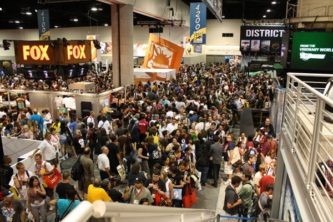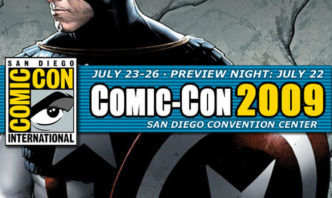 The 40th annual San Diego Comic Convention—or Comic-Con—of July 2009 is now over. I attended, as I have nearly every year since 1987: San Diego, CA was for years my second home, so I was usually always there in time for the con, which occurs during four jam-packed days in July. In this way I’ve gotten a first-hand glimpse at the transformation of this event from a celebration of all things comic book-related to something bigger, more impersonal and altogether different.
The 40th annual San Diego Comic Convention—or Comic-Con—of July 2009 is now over. I attended, as I have nearly every year since 1987: San Diego, CA was for years my second home, so I was usually always there in time for the con, which occurs during four jam-packed days in July. In this way I’ve gotten a first-hand glimpse at the transformation of this event from a celebration of all things comic book-related to something bigger, more impersonal and altogether different.
If you’ve seen the news in the past few days than you’ve likely seen features on the Con, which is now viewed as an integral component of America’s—and much of the rest of the world’s—pop culture landscape. Seemingly every major entertainment outfit in the universe was represented this year, from Playboy, who operated an ice cream truck outside the convention center that lured people with free ice cream, to the UK-based Penguin Books, known for publishing highbrow fiction but operating a booth on the convention floor nonetheless. There were also the movie and television companies, of course, all of which were present—and I do mean all.
I find myself wondering why it is that the event is still called the Comic Convention, since comics seem to have become an afterthought. The big guests this year were movie people: James Cameron, Peter Jackson, Robert Zemeckis and the cast of TWILIGHT and its upcoming sequel. Speaking of which, it was TWILIGHT that appeared to be on everyone’s lips.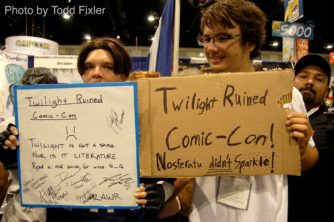
It seems Hollywood views Comic-Con as an ideal way to ignite word of mouth for its product. This began in 1988, when Sony used that year’s con to spread the word on BATMAN. That film went on to become a mega-blockbuster, and since then the Comic Con has gone from an informal congregation of like-minded geeks to a colossal media blitz. As such there is a definite fascination to the event, but it’s far removed from the show I began attending in the late eighties.
Back then the con was held in the old San Diego Convention Center, a modest two-story establishment with a lobby, an auditorium and a few meeting rooms. It was in the summer of 1991 that the con moved into a new venue, a massive three story cruise ship-like structure located on the San Diego waterfront. I vividly recall wandering around this cavernous establishment back in ‘91, wondering how the Hell the Comic-Con could possibly expand to fill this place, with its football field sized auditorium and dozens of meeting rooms. In truth, the con wasn’t big enough for all this, and for the next few years it had to share space with other unrelated conventions (it was amusing seeing the old ladies waiting in line for a 1992 quilt festival staring in horror at the legions of comic book geeks surrounding them). The show steadily expanded, though, to the point that a second convention center had to be constructed adjacent to the first.
Thus in 2001 the size of the con was doubled, yet the event and its attendees continued to expand. Before long the new supersized convention center was jam-packed—and has remained so. This year attendance swelled to a reported 126,000, and I have every expectation that number will increase in the years to come.
The Mark Hamill directed film COMIC BOOK THE MOVIE, lensed at a San Diego Comic-Con, provides a reasonably good portrait of the Technicolor insanity of the event (plus I believe I’m visible in the background of at least one scene). Still, that film was shot back in 2002, and the con has undergone several mutations since then, most of them size-related.
These days, moving about in the con is a delicate process. With ever-present crowds comprising literal walls of people covering seemingly every inch of the convention center, one needs to use stealth to get from point A to point B. It’s a matter of finding the small packets of space
that occasionally emerge within the crowds; politeness has to be thrown to the wind, as blithely dodging in front of people is often necessary. Jostling, poking and even the occasional punch in the face are not unexpected in this sardine-like atmosphere. I always make a point of thoroughly hiding my wallet during these times, as the con would seem a veritable haven for pickpockets.
Another equally complex maneuver facing con goers is getting into a panel. The days when one could simply wander into one of the meeting rooms at any time are long gone. Now you have to wait in a long line outside the room. If it happens to be one of the upstairs rooms you need to find the right hall, as every other hallway up there is blocked off. If the panel happens to be in the mammoth Hall H, located on the bottom floor of the South most edge of the convention center, you’ll need to show up at least in hour in advance to allow time to wait outside.
A word abut Hall H: opened in 2002, it’s the biggest room of the convention center and packed nearly to capacity at seemingly all times. It’s usually reserved for movie studios promoting their upcoming films, although “con favorites” like Kevin Smith also do presentations in Hall H. I’ve seen Kevin Smith in Hall H a couple of times (say what you like about Mr. Smith, but the man really knows how to work a crowd), and also Frank Miller (promoting THE SPIRIT) and panels for SKY CAPTAIN AND THE WORLD OF TOMORROW, STEALTH with Jamie Foxx and Jessica Biel, the TENACIOU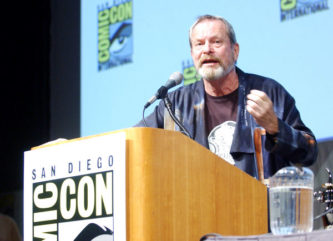 S D movie and SNAKES ON A PLANE. As we all know, none of those films were huge successes, meaning the Comic-Con promotion machine is far from the sure thing it might seem.
S D movie and SNAKES ON A PLANE. As we all know, none of those films were huge successes, meaning the Comic-Con promotion machine is far from the sure thing it might seem.
This year I caught filmmaker Terry Gilliam’s Hall H spiel. He was promoting his new film THE IMAGINARIUM OF DOCTOR PARNASSUS, with co-star Vern Troyer in tow. Gilliam was entertaining enough recalling his years with Monty Python and the new film, which he acknowledged was of interest primarily because it contains the final performance by Heath Ledger. If there was a distributor mentioned I didn’t catch who it was.
Other con regulars include Harlan Ellison (who’s fallen silent of late), Stan Lee, Harry Knowles and Ray Bradbury, apparently a fixture since day one. The eightyish Bradbury was back this year in his usual high spirits, expounding at length on how much he loves life (he also claimed to recall the events of his birth and the interior of his mother’s womb). Though perpetually stern and unsmiling (possibly the result of a debilitating stroke), Ray was quite upbeat overall, without the old mannish we’re-going-to-Hell-in-a-hand basket blather he usually dishes out.
The autograph sessions are another important con component. They occur throughout each day, many of them held in the dealers’ room and many more in the third floor pavilion. Again, there was once a time when you could show up at an autograph session without much hassle, but now getting a signature involves—surprise!—waiting in a very long line.
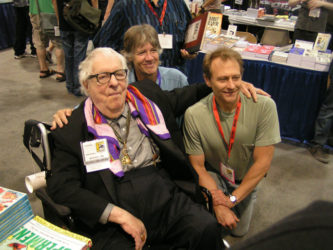 The dealer’s auditorium? Not to keep reiterating the same those-were-the-days theme, but it used to be the place to find good comic book-related swag.
The dealer’s auditorium? Not to keep reiterating the same those-were-the-days theme, but it used to be the place to find good comic book-related swag.
Each year, however, more dealers drop out, with many of my favorites from past years—Mossoglia Books, Luminous Film & Video Wurks, Mythos Books—no longer in evidence. They’ve been crowded, out, it seems, by the movie/book/video game promoters, who in direct contrast to the vendors only seem to multiply. This of course is far from the only hurdle facing Comic Con vendors: according to a bookseller I recently spoke with, the cost for a con booth is insanely high. The one real hope for vendors, said bookseller told me, is to establish relationships with patrons, as the possibility of making any real profit is scant.
If I sound a little sour overall about what’s become of the Comic-Con, rest assured that there are still plenty of good points. This year I saw many memorable sights, such as a goofy band of pirate rockers who serenaded me and those around me at the foot of an outdoor stairwell, and lots and lots of outrageous costumes, always an appealing component of Comic Con. I also got some great deals on quite a few graphic novels, and the free ice cream (see above) was another undeniable plus.

